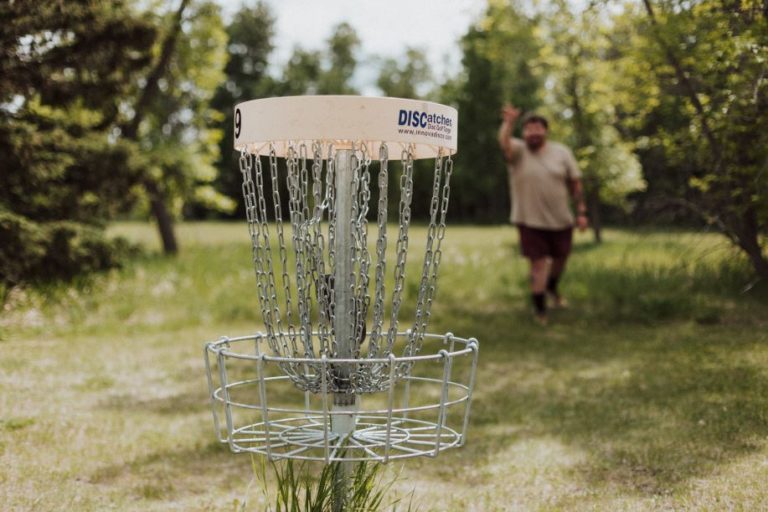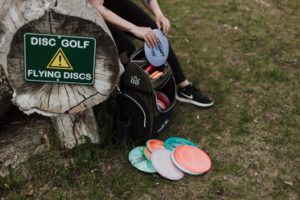By Mary Helen Sprecher
It might have been fueled by the pandemic – when people rediscovered outdoor exercise in municipal parks and were looking for things to do with their families – but disc golf’s growth has continued. The sport was strong before COVID and it remains strong, with new players taking up the game on a regular basis.
The force behind all the growth? According to Brian Graham, director of membership and growth of the Professional Disc Golf Association (PDGA), there are several.
“The pandemic was very good to disc golf and our association because it is an outdoor sport that can be played with self-distancing. In fact, the PDGA doubled in size over the pandemic, going from 53,000 active members in 2019 to 109,000 active members at the end of 2021. We just passed 112,000 active members this year, and the year isn’t over. PDGA members are generally the more competitive type and represent only a small percentage of the millions of people playing disc golf recreationally around the world.”
A big part of the sport’s ability is its accessibility.
“It’s not intimidating,” said Graham. “Disc golf is growing so well because it’s something everyone believes they can do, and so they do it. Maybe not everyone feels confident going out on a field with a football, for example, but just about everyone, at some point in his or her life, has thrown a Frisbee. What’s funny is if you ask people if they think they’re good at it, they will almost always say yes.”
Another reason for disc golf’s growth is its low barrier to entry. Many courses are located in municipal parks, making it easy for someone to gather a few friends – or even just to go out alone – and start playing. There are no membership fees or greens fees, and, for the most part, players can walk onto a course and begin without any equipment other than their disc. Beginners at disc golf tend to be less self-conscious about their game than they would on a traditional golf course, a tennis court or another venue.
“Disc golf is a great sport for parks and other recreational areas due to its low cost and mass appeal to people of all ages and socio-economic backgrounds,” added Graham. “Courses can easily coexist with other park amenities, and can utilize diverse areas not suitable for other sports facilities.”
Along with the number of players, said Graham, “The number of disc golf courses has really proliferated. Parks love putting in disc golf because, while it’s a minimal investment on their part, it brings in people. In fact, when we first started, we would talk to cities and convince them to put in a disc golf course in a park, and they would designate land they couldn’t use for athletic fields or anything else because it was too wooded, too hilly, too rocky, or maybe it just was in a really troubled area.”
That actually began working in the favor of parks, however. “Something the cities would see was that once they put in a disc golf course, it brought in a lot of people,” said Graham. “That extra foot traffic in the park got rid of a lot of undesirable activity. Plus, disc golfers are actually very environmentally conscious; in fact, it’s common to see disc golfers picking up trash while they’re playing. We keep hearing it time after time after time: when you put in disc golf courses, it actually improves the area.”
Interestingly enough, it’s the landscape that makes courses more successful. What some landowners might consider obstacles or nuisances – trees, rocks or uneven ground – are what disc golf players find challenging and enjoyable.
“It’s a lot more fun to have to throw a disc around trees and bushes in order to advance to the next hole than it is to throw in a flat, open field,” said Graham.
While the PDGA has an online course directory that can be searched by country, state, city, etc., it is constantly being updated because of new courses being installed to keep up with the demand.
“Disc golf is booming,” said Graham. “We are seeing growth of our sport at all levels, including the development of many new courses at public parks, private facilities, and even on traditional golf courses. We currently feature over 10,000 disc golf courses in our course directory.”
Disc golf was recently showcased as a demonstration sport at the World Games, held this past summer in Birmingham, Ala., boosting the sport’s worldwide exposure.
Installing a course?
If your facility has decided to install a disc golf course, what should you do? Apart from being aware that it will be vastly different from a traditional sports field (even from a traditional golf course), there are some points to take into consideration.
While installation of a disc golf course is, in fact, less labor-intensive than putting in a synthetic sports field, it does need to be done well in order to result in a finished facility that players enjoy using.
“An 18-hole course can be built for a relatively small investment, and they are best when designed by knowledgeable and experienced designers,” said Graham.
Experts say that courses that get less use generally tend to have been designed haphazardly, by those without expertise in the sport. Finding a sport-specific designer should be the first step.
The American Sports Builders Association (ASBA) has members, including design professionals, who specialize in sports facilities. Ascertain that any prospective partner has experience in disc golf course design.
Why use a professional? Because it is the best way to accommodate disc golfers at various skill levels. A well-designed facility might have several different courses; however, there should be at least one beginner-level course that is clearly marked. This allows the novice player to work on his or her game without being frustrated.
Once a prospective facility has been laid out, have it play-tested by a group that regularly plays disc golf, and who will be able to spot problems. (This group can become your strongest supporters if you cultivate a good relationship and take their advice into consideration.)
Other considerations include:
Adequate clearances: Placing a disc golf facility too close to another facility where active play will also be going on during disc golf games (examples might be a tennis court, a lacrosse field or even a picnic area) is trouble in the making. If discs go out of bounds (it’s not unheard of and particularly with so many enthusiastic beginners taking up the sport), it can substantially disrupt play in those other areas, possibly cause injuries – and definitely be the source of complaints.
Parking and access: People will want to use your disc golf facility, so providing appropriate amounts of parking near it is going to be essential. Having safe pathways that provide a direct route to the start will save your grass or landscaping. And, of course, players should not have to cross busy roads on foot to get between the parking area and the disc golf course.
Maintenance: Disc golf courses do not require the same amount of surface maintenance as traditional golf facilities; however, they do need regular upkeep to keep them safe and playable. The amount and type of maintenance will depend not only on the local climate and the amount of use, but also on the landscape of the course. In wooded areas of the course, for example, it is necessary to trim back brush periodically and to spread mulch on trails to keep them smooth and walkable. In disc golf courses that contain open field areas, of course, regular mowing will be necessary. Note that in many areas, disc golf courses are used through the winter; and some may continue to host tournaments or league play in cold weather and even in the snow.
With a quality facility in place, landowners will discover another market – and a great community amenity. According to Graham, the disc golf industry is not only growing but thriving.
“Years ago, almost nobody had heard of the sport and almost no stores had equipment. Now, PDGA works with about 70 different manufacturers, and we set the specifications for the equipment used in the game.”
Mary Helen Sprecher wrote this article on behalf of the American Sports Builders Association (www.sportsbuilders.org), the national organization for builders, design professionals and suppliers of materials for sports fields, running tracks, tennis courts and indoor and outdoor courts and recreational facilities.




